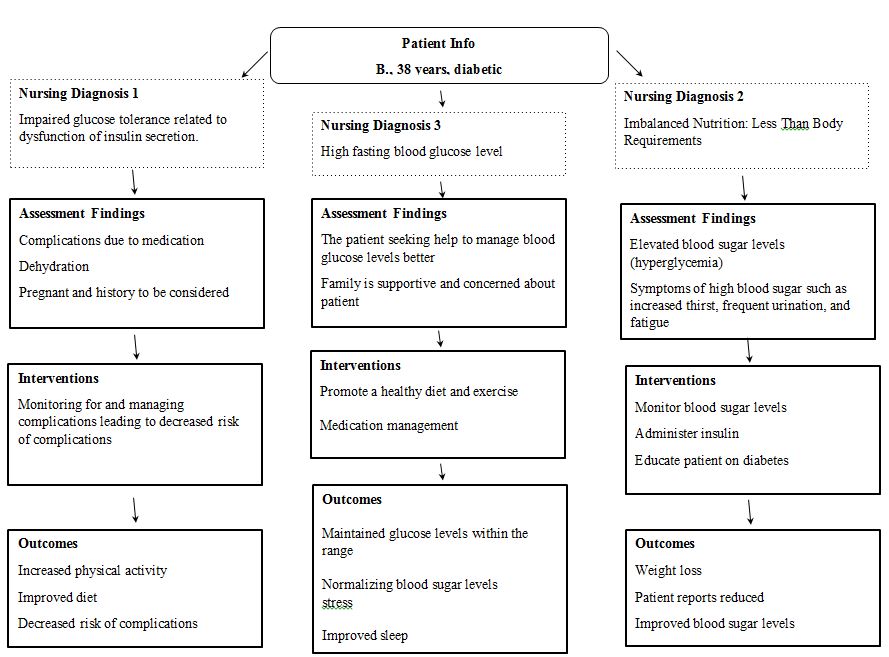Introduction
B. H., to whom the concept map was created, is a 38-year-old woman of Native American and European ancestry and has a daughter who is nine weeks old. Throughout her pregnancy, she was identified as having gestational diabetes. Despite B.’s best efforts, her blood sugar did not return to normal after giving birth to her daughter nine weeks ago. B. is a single mother who laments her family’s lack of social support, the difficulties of juggling parenthood, employment, and other duties, and sleep difficulties. The concept map, created to meet B.’s needs, considers her educational requirements and cultural and racial hurdles to recognize her risk factors and interventions to increase her adherence to the recommended course of treatment.
Needs of the Patient
B. said in the interview that her physician had given her insulin to manage her blood sugar during pregnancy. Due to her Native American heritage, she has strong prejudices, which she has addressed with her mother. After the conversation, her mother, a major believer in her culture, sought the counsel of her society’s elders about the same situation. Therefore, the elders concluded that B. should abstain from utilizing the medication or hormone manufactured in a lab. B. entrusted her cultural practices over the modern ones, and she decided to implement the elders’ advice by focusing on eating well and exercising. In this instance, she is unaware that her lineage puts her at a greater risk of acquiring diabetes mellitus in the future (Jonkman et al., 2020). The indications and symptoms of hyperglycemia and how to treat it must be explained to her. She also has to be educated about the ideal blood glucose levels. Since she is the household earner, it is necessary to evaluate her financial situation to determine if she can afford her prescription. This is done to ensure that she follows her prescribed medication schedule.
Justification and Evidence Relevancy
Evidence-based practice (EBP) has enhanced her health by allowing healthcare practitioners to tailor treatment to each patient’s preferences and values. EBP relies on integrating clinical judgment, empirical data, and practitioner expertise. B.’s potential for causing hypoglycemia when not used in conjunction with conventional medical care is the drug’s primary cause for worry. Even after eating, her blood sugar was consistently above 230, with peaks between 180 and 210 (Vieira, 2022). The elders in her culture have foresworn insulin as an unacceptable therapy (Flanders, 2018). Consequently, considering Dourine’s cultural requirements is crucial to developing an effective strategy for managing her hyperglycemia.
Additionally, her inadequate coping, shown by her reported lack of social support and increased sleeplessness, must be addressed to navigate her current predicament successfully. Due to her isolation as a new mother and parent, B. is more likely to engage in counterproductive coping strategies in response to stress and sleep deprivation (Jonkman et al., 2020). Hopefully, this will inspire her to surround herself with loved ones who can help her through this difficult time. She needs to be forced to take more computer literacy classes so that she may meet other single moms in her region.
Relevant and Measurable Criteria for Evaluation
If B. wants to stay healthy, she has to use the glucometer she was given during her pregnancy to monitor her blood sugar a minimum of five a day. Barabara’s blood glucose levels before and after meals should not exceed 120 and 175 mg/dL, respectively (Vieira, 2022). Therefore, to ensure that she follows instructions and uses the glucometer properly, she should be asked to record her blood glucose levels and bring the findings to her next appointment.
Communication Regarding Concept Map
B. must see her doctor to have her idea map fully understood. B.’s family and history are the most critical factors for the doctor to consider. It is also essential to consider B.’s emotional and mental health when creating a plan of care. Any information about diabetes care must be presented to her straightforwardly. A free-form inquiry into academic, cultural, and monetary needs is required, as well as an assessment of her support system and living environment. The doctor can create a comprehensive plan tailored to B.’s needs with this information (Figure 1).

Conclusion
In conclusion, B. requires assistance in understanding the evolution of the illness, the risk factors, and the importance of adherence to diabetes treatment, all of which may be aided by implementing the idea map. Dourine’s connection with her healthcare provider may be strengthened by using a comprehensive approach to her treatment. Last but not least, her cultural or ethical background, socioeconomic state, and learning capabilities must all be considered to guarantee that she understands and follows the treatment plan established for her.
References
Flanders, S. A. (2018). Effective patient education: Evidence and common sense. MedSurg Nursing, 27(1), 55-58.
Jonkman, L. J., Ndungu, M., Connor, S. E., Sharma, V. B., Pattabiraman, R., Zaver, A., Castillo, T., & Meyer, M. (2020). A qualitative assessment of diabetes care access and disease management in Central America. Research in Social and Administrative Pharmacy, 16(11), 1542–1549. Web.
Vieira, G. (2022). What are normal blood sugar levels? Diabetes Strong. Web.